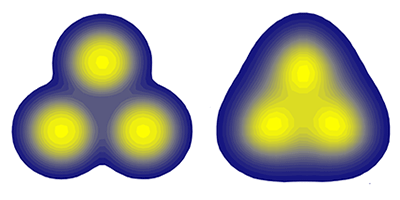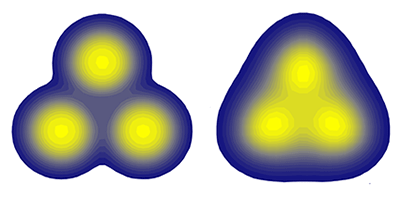An Untested Window into Nuclear Structure
The internal structure of nuclei is far from simple: protons and neutrons in a nucleus tend to form helium nuclei (alpha particles), which are then thought to arrange into structures like those seen in crystalline solids, a configuration known as alpha clustering. For example, the ground state of carbon- ( C) can be envisioned as three alpha particles bound in a triangular arrangement. So far, there is only indirect evidence for alpha clustering, which comes from comparing model calculations with measurements of the binding energies and excitation spectra of nuclei. Now, an experimental proposal in Physical Review Letters suggests that direct evidence for alpha clustering in light nuclei such as C, O, or Ne could be observed in high-energy nuclear collisions, such as those performed at Brookhaven’s Relativistic Heavy Ion Collider or CERN’s Large Hadron Collider.
Researchers have strong evidence that when two large nuclei (such as lead or gold) collide at relativistic energies they form a hot, dense medium called the quark-gluon plasma (QGP). This fluidlike plasma expands rapidly, leading to an explosion of particles that are measured in building-sized detectors. Based on calculations, Wojciech Broniowski of Jan Kochanowski University in Poland and the Institute of Nuclear Physics at the Polish Academy of Sciences and Enrique Ruiz Arriola of the University of Granada in Spain demonstrate that the spectrum of emitted particles should be sensitive to the spatial distribution of nucleons in the colliding nuclei. Specifically, if alpha clustering occurs in C, then lead-carbon collisions may generate what heavy-ion physicists call triangular flow—a characteristic momentum asymmetry in the pattern of detected particles.
Experimentalists at CERN are already planning to look for the effect. Meanwhile, the proposal is a welcome addition that may help resolve questions in two disparate fields—low-energy nuclear structure and high-energy quantum chromodynamics. – Kevin Dusling





